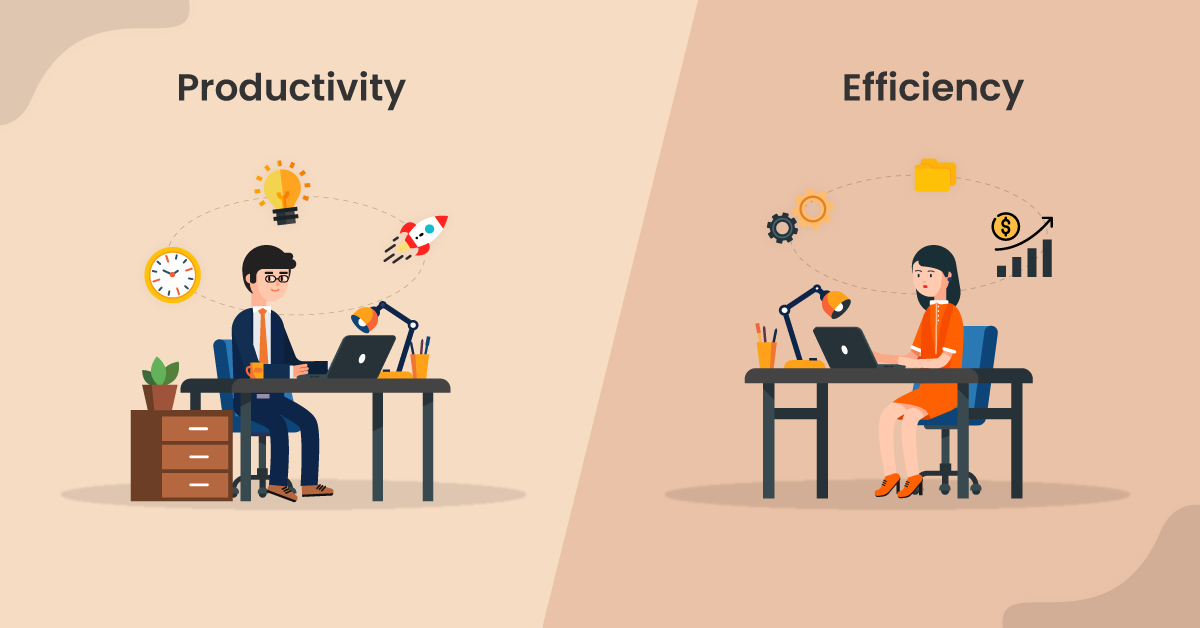Posted on: January 5, 2024
Work Efficiency v/s Productivity – The Difference and Why it Matters?
Get started
In the current world of technology, two things are crucial for the success of any individual and organization simultaneously. It is the productivity that is coming out and the efficiency that is channeling productivity. When combined, work efficiency and productivity are different but essential for the company’s growth.
Tracking employee productivity has become essential in this era of remote work. As per Reports, from roughly 2000 UK employees, 79% of workers say they are unproductive for an entire eight-hour workday.
Although the average employee is 60% productive, employees working from offices are only productive for 31% of their workday. Productivity tracking helps set an accurate benchmark and identify areas for improvement. Productivity is quantitative, While efficiency is qualitative.
It should be noted that inefficiency can cost organizations up to 30% of their income each year. Productivity will help in getting the details of the quantity of work done by the employees. However, it can not give insight into the quality of work that each individual has given.
In short, workplace efficiency and productivity are synonymous, but the concepts are entirely different. The terms are not interchangeable, and the distinction between them is a question of quality versus quantity.
Table of contents
Defining Work Productivity
Defining the term is important to understand the meaning of work productivity. However, the definition of work productivity depends on how your organization views productivity.
Therefore, we define productivity as the mechanism that allows us to calculate the output compared to the effort. A simple equation for work productivity is :
Employee Productivity = Total Output/Total Input
The meaning of output and input varies according to your organization’s business, industry type, and operations. In general, most companies will consider the tasks accomplished by an employee over a particular period.
This accomplishment is checked by considering the task’s amount, quality, and timeliness. However, you can also assess productivity by comparing the overall time spent on each job to the equivalent output. There are some typical ways through which we can increase employee productivity.
These ways include productivity calculation through individual employees and team productivity. It also includes the organization’s overall productivity, project, and process. Employers need to follow some guidelines to determine the areas of improvement in the process.
These guidelines include tracking the time and resources to complete the assigned task or project. This will help improve employee productivity by completing the task at a higher number or with the same number but with higher quality.
Identify Key Performance Indicators
One of the most important steps in measuring productivity is evaluating employee performance through Key Performance Indicators (KPIs). We know KPIs as an efficient metric that we can use for reviewing employee performance.
The KPI consists of several indicators, which together help measure performance. These can include completed tasks and their accuracy, along with the quality of work and timeline involved.
KPIs will change from company to company depending on the target the company wants to achieve. It is important to ensure that your KPIs are measurable and relevant to the job position. They must also be practical and attainable.
Finally, you must examine KPIs regularly to ensure that they continue to make sense for the organization over time. Once the KPIs are designed, you must convey them to the employees. This will help them to understand the objectives and performance growth.
Employees will require feedback on their performance. These feedbacks must be against the KPIs throughout time so that they may observe their progress. It will help to boost employee productivity.
What is Work Efficiency?
Work efficiency is defined as the ability to get the most out of the least amount of input. Here, the efficiency is regarding the employee. In simple words, it means getting more done with less. It thus requires time management skills. It is working smarter rather than harder.
When you increase workplace efficiency, you might get more output from the same amount of input – or even less. This means being able to achieve more in a limited amount of time. It helps the organization’s and the employee’s overall growth simultaneously.
To calculate work efficiency, we can use a standard formula. Work efficiency can be calculated using the following formula:
Output/Input = Efficiency
The output is referred to as the standard labor hours. The input is denoted as the actual number of hours worked by employees. Then, divide that by 100 to get the percentage. That is your work efficiency.
How to Increase Efficiency in the Workplace?
To learn ways to improve work performance, it is important to put dedication into action. Like any other self-improvement plan, it takes time and motivation for the improvement to happen. You’re simply developing new behaviors to boost employee productivity rather than detract from it.
Setting Goals for Increasing Work Efficiency
Setting goals is essential for achieving success. We can set goals to help in shaping our route to success. It is a powerful method to increase work efficiency. According to research, individuals can enhance their work performance by as much as 20-25% by setting goals.
Unfortunately, we may not have set achievable timeframes for those objectives and goals. Also, we may have set them too high, so we cannot increase work efficiency.
Compelling goals is crucial. However, it would help to consider how much time and resources your goals will demand. We can go directly from A to Z to attain our goals. However, there are other steps in between that must be considered.
Keep your ultimate aim (Z) in mind, but consider steps B, C, D, etc. Setting achievable goals will allow us to focus on the target and its outcome. You can not correctly focus your mind and energy on a goal that is not specific or difficult to achieve.
Correlation and Differences between Productivity and Efficiency
Productivity and efficiency are linked to each other as they are responsible for leading to improvement. This improvement can be at the individual level or the organizational level.
Increasing workplace efficiency allows for better management of resources and workplace flexibility. Therefore, it leads to an increase in overall work performance. In contrast, being highly productive only sometimes implies being efficient if resources are used properly.
Productivity vs Efficiency, Summed Up
The significance of productivity and efficiency changes according to the situation and goals. Sometimes, maximizing productivity is important, particularly when deadlines or high output requirements exist.
On the other hand, focusing on efficiency can be more advantageous, especially when you have limited resources and process optimization is a top priority. Therefore, balancing productivity and efficiency leads to long-term success and effectiveness.
Importance of Productivity and Efficiency
Calculating productivity is a great starting point for the improvement of the organization. It leads to better performance and output. Thus leading to improvement in work efficiency. However, these calculations are helpful only if we work on them.
In order to achieve this, it is important to have an action plan and set goals. These actions must be reasonable and achievable. We fail to achieve our goals not because we are not efficient.
But, because there is a lack of motivation. Relate your daily work to your goals and set objectives to overcome this barrier. Leapmax offers several solutions to track and improve productivity.
It ranges from labor hours to employee attitude and beyond. The employee monitoring software of Leapmax helps evaluate the KPIs with the help of workforce analytics. Through such employee monitoring tools, it becomes easy to track employee productivity.






